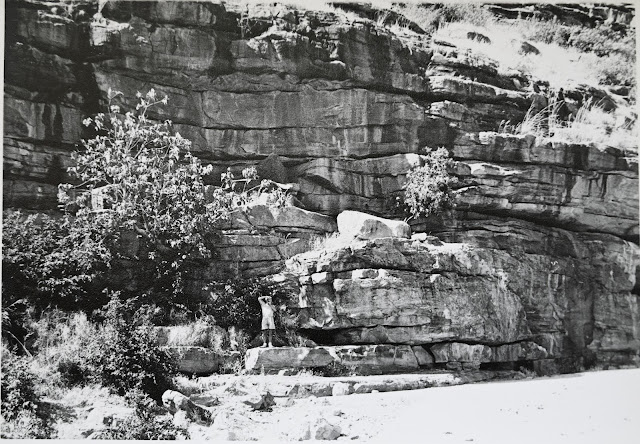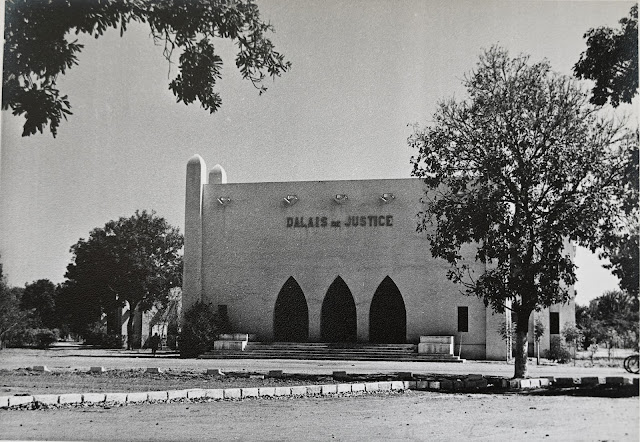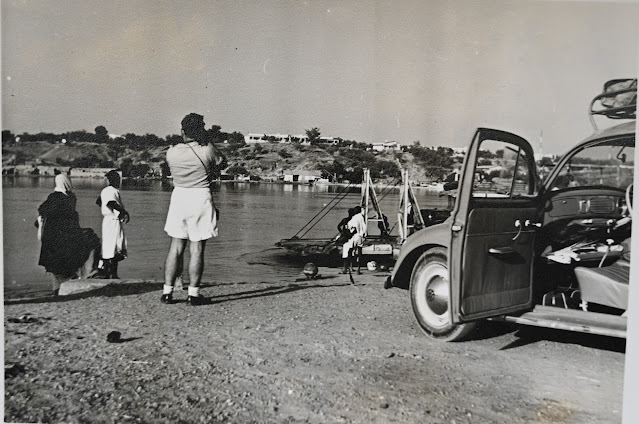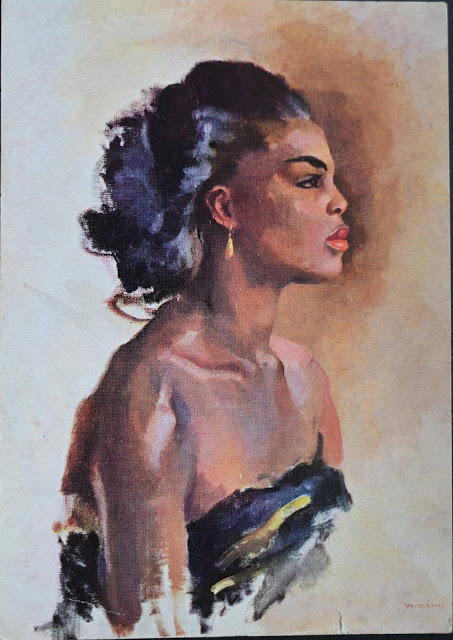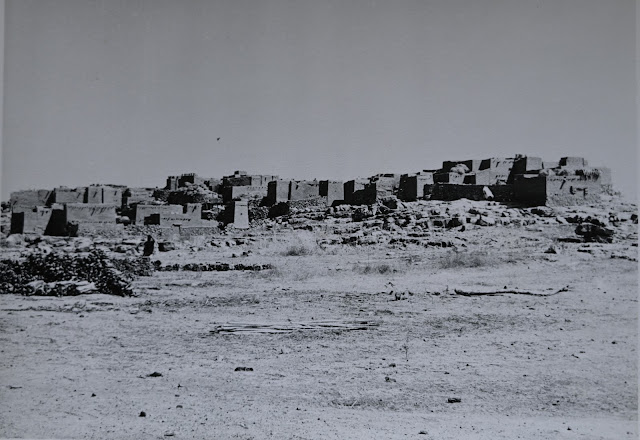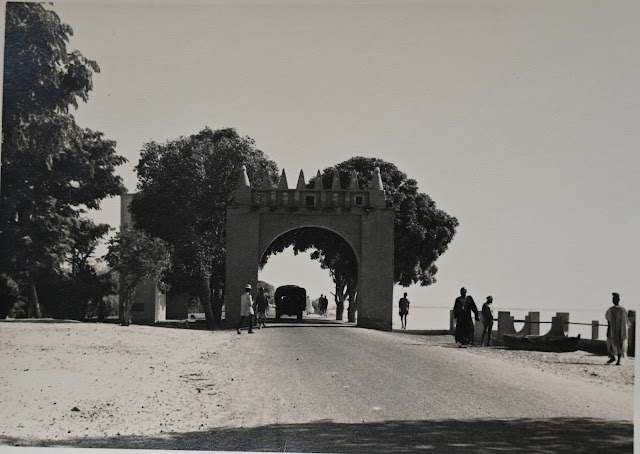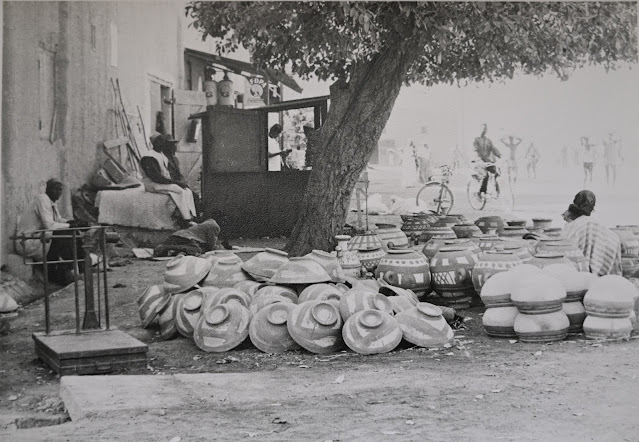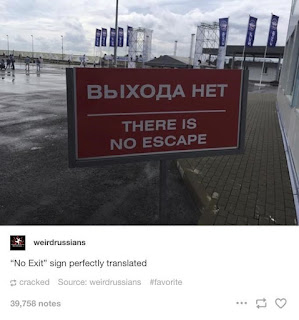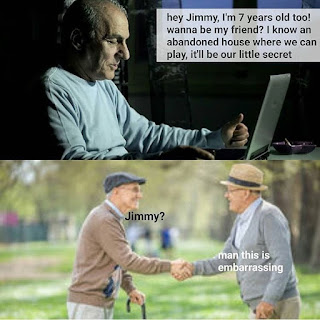Notes on a journey to Timbuctoo, the lakes of Gormaa and the Dogon country, an account by 2 authors, Grandad and Pugh
From: 19th to 30 December 1957
Volkswagen (pink)
Mike Messenger, 28, radio engineering lecturer, short. Bill Burberry of Broadcasting Engineering dept, 37, cheerful, reliable, excellent French.
Volkswagen (blue)
Warren Marsh, a quantity surveyor, 25. Large, boyish over-enthusiastic motorist.
John Pugh; "something in the ministry of health", 37, small, witty, competent organiser.
Opel caravan (grey)
Brandon-Jones (BJ); civil engineer, 52, could mend anything, steady as a rock.
Harry Ebbs. Engineer, 35 also very handy and willing to help.
George Reynolds, Headmaster, 47, overkeen photographer, French less good than he thinks, apt to stand and watch work in progress.
Itinerary: Accra-Kumasi-Tamale-Navrongo-Ouagadougou-Niamey-Gao-Bourem-Timbuctoo-Gormaa Rharous-Douentza-Mopti-Ouahigouya-Ouagadougou-Navrongo-Tamale-Kumasi-Accra
Total distance: 3050 miles. Several meetings were held to arrange supplies and so on, originally trip was based on 2 cars and 4 people. Many others wished to come but could not raise a reliable car. My VW had its back seats removed and a wooden floor and ledge added giving a very large boot for food, water flagons and a tank, tins of kerosene and motor oil and vast quantities of oranges in all the gaps. A roof-rack held another spare wheel, our 2 beds and a sand mat. Clothes in the front of the car and also a portable radio.
**Written in 1957, this was an honest traveller's account of what they saw and experienced. But, as borders, rivers and political landscapes have changed in the decades since, values and observations may differ greatly to what is accurate or culturally acceptable today.**
Thursday 19 Dec 1957
5pm, 0 miles. Away, having been slightly delayed by a neighbour who said there was "a native sitting in her bungalow: what should she do". The obvious answers were apparently inappropriate as her husband Colonel Brown who was watching outside thought he was a Teefman (thief). Informed Cantonments police.
Weight of VW with Marsh, myself and kit (including food for 8 days, cooking gear, campbeds, mosquito nets, blankets, sand mats, shovels, beach umbrella, jerricans, spares, cameras, binoculars and Bannerman) = 22 cwt which was maximum.
Passed a newly burnt out VW bus before Aburi. Fireflies came through open roof and alighted on the back of my hand. In the light they were like pieces of soot.
3 stops to adjust spotlights. No noticeable differences but Marsh, who exuded an obsessive pride in the massive bumper bar and grill protected spotlights declared himself satisfied each time.
Passed herds of cattle on their 800 mile walk from the north to the slaughter houses of Accra: driven by Fulanis. Long curved horns, ice green eyes in the headlights.
930 pm, 177 miles. Kumasi resthouse, after filling with 14 gallons of petrol at 4 shillings and thruppence. Dinner at club, (bacon, sausage and eggs and beer). Messenger and Burberry had arrived first and claimed the booking of "Marsh of Survey Dept", hogged 2 best beds so rest used safaris in Mrs Gunn's bungalow.
Friday 20 Dec 1957
Not a very restful night. Few mosquitos, but many moths, cockroaches, fireflies. Up at 430 am. Indifferent breakfast of boiled egg (1 of 4 bad) bread and butter, marmalade, glucose, Paludrine and salt tablet - thus providing all the requirements for nausea. Met BJ, Ebbs and Reynolds at club having an early breakfast. They had arrived 1130 pm.
535am, 0 miles. Away from Kumasi. Twisty roads wet and heavy mist on Mampong scarp. The high forest dark green and wet. Stopped on the hour at 7am - the rule followed through trek on the good roads. Temperature 74 degrees.
Early morning activity at Pioneer Tobacco Company, Ejura. 8am heavy mist required windscreen wipers. More like north Wales. Cool. Bateleur eagle and Bell Shrikes on road straight as a die.
Marsh pursued and ultimately killed a gentle ground squirrel. Heavy forest giving way to orchard savannah.
855 am, Yeji. Ferry across the Volta. One ferry was out of order so long line of overnight mammy lorries ("why worry" and "still why worry"). Signed book as government officers and took priority. 40 minutes delay - one lorry, stuck, blocked exit from and entry to ferry: BJ gave authoritative and useful instructions.
Herds of cattle swimming the 400 yards wide river - noses and horns high - on their way to the South. A few of independent turn of mind swam downstream or tried to return. Fulanis pursued them in canoes or swimming.
Red breasted swallows nesting under pontoons.
218 miles, 1115 Lunch: early to avoid intense heat. Temperature 94 degrees. Away in 25 minutes. Marsh complained of insufficiency of food: revealed he had brought a private supply.
247 miles, 1210 pm. Tamale. 8 1/2 gallons at 4 shillings and 8. Delivered false teeth adhesive to Dr Turnbull at PMO's office. Received good wishes from Hingston, Sappor, Ladeji - and Rene Clapton. Beer at the club and took on 5 gallons of drinking water. Modern buildings springing up at Tamale.
1250 pm away. Northern Territories landscape now - flat, dried up, burnt out under a pale blistering sky. Relieved only by occasional Bombax trees, gaunt and leafless but decorated by clusters of waxen pink flowers, brilliant against the blue sky. Uneventful.
351 miles, 310 pm at Bolgatanga. 2 1/2 gallons of petrol at 4 shillings and 11, in fear of French prices. Market day (always an even chance, since it is held every other day, yet the small boys anxious to guide and earn a dash announce it as if master were indeed a favoured man). Most famous market of Northern Territories and noted for its coloured baskets and hats. Reynolds tried to barter a guinea fowl (domestic - BJ thought it was wild) for a hat - but in the end only got 2 shillings. The wily Muslims said they were in the middle of Ramadan and therefore a fowl was valueless to them. Away at 325 pm.
388 miles. Crossed border between Navrongo and Po and cleared customs at Po. The African guard said that photographs were interdit. Validity of Burberry's laisser passer queried by incomprehensible French Douanes. Told to get it endorsed in Ouaga (but did not suppose he would).
Banana bushes. In the dusk saw 2 duikers on atrocious roads.
458 miles: 7pm Kombisiri. Campement sommaire. New concrete building but badly maintained. No doors to 3 rooms, but amazingly it had electric light. Cooked supper of sausage and potatoes heavily flavoured by kerosene which Messenger had liberally distributed in filling the primus.
Mileage to date: 635. Average mph for day 33.8.
Saturday 21 Dec 1957
545 am away, Kombisiri. Early morning travellers on road - cold Africans swathed in robes and dirty clothes, pale donkeys, clearly revealing the mark of the cross; overloaded donkeys and overloaded bicycles - the latter in the majority.
Road travels along 3 lakes. One lazy crocodile.
Ouagadougou. A rose city in the rose light of dawn. A wonderful sight, my first viewing of French colonial architecture of simplicity and space. Broad avenues, ferroconcrete new buildings, square and cube native houses; all rose pink - even the self conscious Palais de Justice. Saw a small stadium and an impressive market building. No petrol pump open until 7 - so pressed on to Fada along a dual carriageway and we were soon into open country. Not many hills but often the road descended to cross one of the many dried-up river beds. The occasional village now looked more picturesque and less squalid than in our own northern territories and we decided it was "Real Africa" more like Kenya and Rhodesia. The map shows it as lion country.
745 am, warming up. Temperature 68 degrees. Clean and fresh in the early morning air. Terrain: barren, dull black rocks, greatly burnt out areas, stunted bushes, occasional wisps of tinder dry grass. Baobab trees. We stopped to take photograph of the rocky outcrops. Marsh said "unless we're careful the cars will get into every photograph". Messenger pulled up in a swirl of dust as we moved away. He shouted "wait; we must get a photograph of the cars".
117 miles, 845 am, Koupela. Junction for Bawku, which would have saved us 100 miles but roads were reportedly bad. Average 39 mph.
1015 am; Continuing on the wide and very good laterite road (main east-west communication in French west Africa), reached Fada N'Gourma along the tree-lined avenue by the lake (didn't expect so much water here). 35 litres at 36 Francs per litre at the Total fill-up station. Spacious town of many roads and wide scattered round huts in a flat yellow plain. Not market day. Well fed sleek donkeys. Due to lack of time, we passed reluctantly large new hotel run by Italian. This new and unexpected amenity on the trans Saharan road does well because Fada is in the centre of good hunting country.
11am, after lingering in Fada for photographs catch up Messenger's VW. They had changed a wheel after a puncture on the "track difficult or dangerous" brown dotted line on the map. Temperature 94 degrees. Plain antelope. Marsh led convoy by driving fast but at cost of higher petrol consumption.
198 miles: 1120 am. 40 minutes stop for lunch with dirty hands from the wheel change. Realised if we were to catch last Niamey ferry (430 Niger time) we must steam.
1230pm. Passed BJ's Opel with puncture. Road laterite, slightly loose surface, sometimes ridged; one long patch of thick sand. 45-55 mph, easy speeds. Bateleur eagle on wing. Flocks of emerald starlings. Very few Africans.
155pm, 95 degrees. Kantchari. 38.3 mph. Noticeable here as elsewhere that women almost invariably wore something red: usually a cheap print, red scarf square.
335 pm puncture. 340pm away, having changed wheel and replenished petrol tank from jerrican. Chances of catching last ferry receded; but Marsh fairly threw the VW about the rough road to avoid losing speed. 403pm an electric short in the fuse box sent a stream of acrid smoke through the car. A tin of Johnson's Prickly Heat powder had provided the short circuit.
Masses of doum palms standing in clumps like cypresses in an English churchyard.
410pm (440 Niger time) arrived on ferry just as it was about to push off. Discovered last ferry 645 pm. Ferry turned a laborious circle to return for Messenger and BJ who arrived minutes after us. Power-driven ferry took one mammy lorry and our 3 cars over the narrow but deep river. BJ expressed the unwisdom of running cars full out in the heat of the day and on bad roads.
358 miles, 430 pm Niamey. Highly attractive capital of Niger, and famous for ivory trade. Sprawling town with usual massive French administrative buildings and centre market where we saw camels for first time - and cattle, goats, donkeys, horses; and horsemen gaily caparisoned. No tryps here.
40 litres of petrol at 34 Francs (Marsh carefully avoiding Total, which at Fada, had seemed largely kerosene). Spent one hour fruitlessly trying to find someone to repair tubeless tyres (at 530pm on a Saturday): at least this was my impression, although once in our circuits of Niamey we visited an ice cream factory and a magic show. Eventually mended puncture ourselves in courtyard of campement. Marsh and I mended our first tubeless and had doubts about its success. Messenger and Burberry removed the cover from punctured tyre - to discover there was no inner tube and that the strange writing on the outside (schruckloss) was German for tubeless. Difficulty resolved by putting in a tube, cleaned out air filters. Insisted on a beer at any price which wasn't too bad- 90F (about 3 shillings) served by a French woman.
370 miles. Very comfortable campement at the one-floor Terminus Hotel. Dinner, by fountain and coloured lights, consisted of soup, chicken and red pepper sauce, and tomatoes, steak, cheese, pudding and brandy sauce: very strong red wine. Dinner, bed and breakfast at 4am, cost 1080 each.
Total mileage now 1005. Reynolds busily acquiring local information, was difficult to prise from the bar. Cheetah in a cage in the courtyard, and a chimp on a chain. Tried to get some sleep but the hotel was only 30 yards from a bar with no closing time, they quietened down at about 0230.
Sunday 22nd December 1957.
After breakfast French style, away Niamey 450am in the dark past good modern shops. Collected a large thermos of ice cubes from bar steward who was still on duty from previous night.
Road tarmac as far as Residency - a yellow fortress on banks of Niger. Armed sentry was awake. Road then rough and corrugated with occasional deep gullies usually signposted. Flat yellow country except where Niger wound through lush green. Road followed river at distances between a few feet and 2 or 3 miles.
Many nomad Fulani encampments with their unsubstantial tents of black striped matting; and hump backed cattle. Occasional fine healthy horses, front feet hobbled. This area and further north marked for many cattle the beginning of the long trek to the butcher's shops of Accra.
6am, 61 degrees - still chilly with the windows open. I had acquired Marsh's heavy cold. Messenger asked Marsh "Any Benzedrine?" He had had 3 nights of poor sleep and felt his eyes closing while driving. Marsh who doubtless could not easily locate the Benzedrine (because he'd forgotten to bring his "Keep Awake" pills), brightly suggested that Burberry should drive.
Many guinea fowl and pied crows (which were sparse in the northern territories). Great waves of white egrets flew downstream.
74 miles, 7am Tillabery. Average speed, 37 mph.
Passed military convoy. French officers in jeeps furiously driven by Africans.
127 miles Ayoron (Agora). Important village on left where clearly it was market day. Passed many loaded donkeys, and donkey caravans converging on Ayoron. Women wore satin black and the men a sort of white burnous. Features less negroid, but very black: Bambaras. Important men on horses or camels.
Flat and mostly bare scrub; but large areas as devoid of vegetation as an aerodrome. But everywhere birds - egrets, black magpies, starlings: and 2 crown cranes.
11am. Lunch under a tree by the side of Niger. Village some distance away on a hillock, safely removed from Niger which floods extensively. Watched at respectful distance by village men and boys: and ostentatiously ignored by busy little fire-finches. Women wore attractive and intricate hairstyles; much better fed than NT women. I gave a small boy a piece of ice and in wondering speculation it was hastily passed from one small hand to another - as if it were too hot. As always one sophisticate among them had been to Accra and was able to explain all. They were happy to take our empty tins.
1145am away - to pass BJ who had chosen to eat away from the curious villagers.
Many sheep in the dried up yellow grass. Almost as tall as donkeys - black and white, or white, or brown and white and some fat black ones with thick black coats, seemingly more suitable for the north of Scotland.
Naked little boys, usually in pairs - administrative masters of herds of enormous hump backed cattle. A great bustard. Occasional copses of thorny green epineux. Laterite cliff on left. Crossed the border into French Sudan. The border guard had no idea what to look for but stopped us anyway: we were friendly so he let us through. Rapids and a giraffe were marked on the map, but we saw neither.
Arrived in the attractive town of Ansongo at 1pm. It was a travellers delight with a very blue river on one side and a very yellow desert on the other. As at most times this desert was not the ideal sandy waste, but contained sparse and scraggy bushes. The buildings of Ansongo demanded photographs and also a view down a little alley to where women were washing in the Niger.
286 miles, 245 pm Gao. Chef lieu de cercle. Important river port with a tarmac road and a small airport. Petrol 40 litres at 40 Francs out of a roadside lorry as Total was closed for Sunday. Beer 120 Francs bottle at Air France hotel. Proprietor said rate for £ was 450 Francs. We thought this was a poor comparison with 670 at Po. He said rate in Timbuctu was 330. Marsh confused BJ into wrong payment for petrol and vexed Messenger by hastening away before he had had a beer at the Atlantide Hotel. We got our 25 litres of petrol for 1000 francs, the most expensive of the trip. Our range with the jerry-cans full was about 500 miles in good going so we needed all of it. However, the departure of the whole party was accelerated by a doubtlessly unfounded rumour that passports required scrutiny.
345 pm away from dusty, sandy, not very clean Gao, next to a sign bearing the magic symbol "Tomboctou".
339 miles. Desert proper began - sparse scrub and rolling dunes. Passed a camel caravan carrying salt bars, sides of camels badly lacerated. Occasional pairs of camel riders mostly Arab - the chief magnificent in his blue burnous and white litham, pale caucasoid face and long black hair. In his hand 2 or even 3 spears, he would stand impassive, whether we passed or stopped and photographed him.
This is where we started to doubt our own maps - some places on it don't exist. Drove slowly past the camel trains to avoid startling them.
520pm, Bourem. We climbed up to Bourem on the hill in fading light as we were 15 degrees north. It comprised 3 large fortresses - each flying the tricolour - and a handful of mud wattle houses on a hillock overlooking the bend of the Niger. Stayed at largest most commanding red laterite coloured fortress: looked like a foreign legion fort but was actually built as a prison, on a steep hill reeking of Beau Geste memories.
Guardian put on fine dinner of soup, pasta, steak and potatoes, egg custard sweet and red wine for 175 Francs. Messenger had had 2 punctures, and cleaned the engine, changed the air filter and engine oil and greased the suspension. He also enjoyed a midnight attack of vomiting which he ostentatiously enjoyed in various parts of the fortress, including over the battlements.
Total mileage: 1353.
Monday 23rd December 1957
Awakened by George at 5am. Felt a bit rough with heavy cold, sore throat and stiff limbs. Large bowl of steaming coffee.
615am, away Bourem. Pale translucent sky over the buildings of pink, violet and white clay for which Bourem is noted. This was a late start. There had been the previous night a strong and sustained objection to another crack-of-dawn start, to constantly arriving in darkness and leaving in darkness. Marsh and I did not share this view - but we had no punctures and had arrived in daylight. Generally, however, the need for pressing on to Timbuctoo was agreed.
As a result of Reynold's talk with French geographical surveyor and our own credulousness, we took what purported to be a better road out of Bourem (the road to Tessalit which ends up in Algeria) and got lost. But saw at close quarters 2 gazelles. Eventually went back 10 miles and restarted on proper road clearly signposted Timbuctoo. Terrain, rose red, iron hard alternating with sand. Plenty of thorny epineux. Gazelles in twos and trees and 3 Sudan bustards. Single ostriches examined our passage objectively from grass tussocked dunes.
60 miles, 815 am. 73 degrees. Average speed 30mph.
9am. Track forked. After extensive reconnaissance by Marsh we all took wrong track past a series of Tuareg villages full of cows, goats and donkeys, with dogs that raced us for a mile before giving up. Later in the cool clean invigorating air Messenger said he couldn't understand why Marsh had led for so long along what was clearly the wrong track.
110 miles, 1025am. Onto causeway which was intersected by fast west flowing stream, where Warren was stuck, and we spent ages wading around trying to find a ford. Long discussion with Bambiye Africans who clearly could not understand our difficulty in getting to Timbuctoo and amongst ourselves, as to why the stream - part of the Niger - was flowing west and not east. Latter problem was quickly solved and so was former at 11am when we followed faint tracks north across scrubland and joined a heavier track going east-west, like we actually wanted.
1130am. Lunch on rounded knoll overlooking Niger. Knoll composed wholly of broken pottery. No village near. Niger wide and slow moving among banks of green borgou grass. This grass contains sugar and is fattening for cattle.
1220 away. Track generally hard, but patches of loose sand. Many sleek and handsome donkeys, wild in the sense of wild Welsh ponies. Occasional shepherd boys naked or in blue guinea cloth. None with umbilical hernia, and no villages for 150 miles, despite all the wandering humans and animals. At distant intervals we met enigmatic single Arabs on enigmatic horses, whose sole occupation seems to be gazing enigmatically into space. There may be perhaps a dozen private cars along this road each year, yet they did not bat an eyelid. The 2 villages of Rhergo and Sakamar on the map failed to exist.
192 miles. Patches of soft sand more frequent. Some gazelles: once a herd of 12. Many ground squirrels with black or white ringed tails. Once a congregation of huge vultures (Nubian vultures or white-headed vultures?). Neumans chestnut winged starlings near the cliffs.
202 miles, 315pm. 91 degrees, average 22mph. Road frequently divided into many tracks over areas of loose sand. Continued to follow tyre marks of large vehicle and hoped it went to Timbuctoo. Opel sometimes in difficulties but was usually pushed out by its own passengers. We kept within sight of each other. The road got steadily worse with sand. You'd get a mile or so of flat track and then a hill and sea of soft sand. The good sections got shorter over the last 100 miles which was an excellent apprenticeship in sand motoring, and we learned as we went. Someone starting off from Timbuctoo going the other way would meet the worst conditions first and surely give up. We slewed drunkenly from one side of the tracks to the other with high engine revs in second or even first gear.
223 miles, 430pm. Terrain now wholly loose sand, maintained to a negligible degree by coarse grass, an area of gentle slopes and rises with occasional deeper sandy gullies. VWs experienced no real difficulty, but Opel frequently came to a standstill, Ebbs suggested possibly due to paraffin in the fuel from Gao. Magpies and ground squirrels.
Just as we were planning to camp out for the night, 5pm with Timbuctoo on the horizon all 3 cars came to a standstill in ragged echelon. The over-heated Opel was the most difficult.
530pm, Timbuctoo: arrived by way of a well, an alley and the beehive huts of Bela Farrandi. In the gathering darkness Marsh led the convoy in a lightning tour of the city finally coming to a halt, confidently but unnecessarily, at a military fort and the parade ground of the foreign legion. Burberry's immaculate French took over so he hired Mohamanodu, a small Arab boy as guide and thus we quickly arrived at the resthouse to find the accommodation taken by Achimota, a French surveyor and 3 white friends. None of these folk thought it was possible to arrive by car, they had either flown in from Ghana or by boat from Nigeria. They were all University people and quite mad.
We consulted the Commandant who meticulously shook hands with everyone twice but was otherwise not interested. The shifty-looking caretaker suggested we could use the unfinished guesthouse. We put up our beds on the roof of the campement - Ebbs and I under a mud overhang on a floor decorated with tiny mounds of bat droppings, dry and brown like coffee grounds. The rest slept in the open.
The bearded lecturer from Legon told us there was a Ghanaian photographer in town anxious to exchange francs into pounds, even at 600. This was good news indeed as we had become very short and there was no other chance of exchange.
Burberry engaged 2 small French speaking Songhai boys as watchnights because Mrs Heyman was quick to warn us (no doubt inaccurately like other local information) that the caretaker/guardian was a teefman. Burberry had experience of this and trusted that all Arabs were untrustworthy. Monster dinner of Irish stew - ragout cooked by surly young guardian, with some tins of food we'd given him. The local café looked dingy from the outside but was quite good inside with lots of cold beer and wine. We had a nightcap there but it was cold and we were tired; we slept well under mosquito-free blankets. We saw the bright crescent moon and single evening star so beloved of Islam.
233 miles total mileage 1586.
Some historical notes on Timbuctoo
Lies where the river and desert meet. The north bound wealth of the tropics and the southbound products of the Barbary coast meet at Timbuctoo.
First mentioned in about 1076 when Ghana was the predominant power in Sudan. It was a trading centre and also became a dormitory area for the Tuaregs from the north, the Songhai from Gao in the east, and for the Bambara from Djenne in the west.
1336: Timbuctoo and the Songhai came under Mandingo (Bambara) control and Timbuctoo began to acquire its reputation as a seat of Islamic learning. Byengerey Ber, the great mosque was built.
1420 or so, Mandingo authority waned and the Tuareg captured the city.
1468 began the Songhai era and the age of Askia the great. Timbuctoo became one of the important towns in the great Songhai empire which stretched from the Atlantic to the Nile and as far south as the forest belt of present day Ghana. The peripheral areas were doubtless never integrated. The Judge of Timbuctoo was automatically the Chief Justice of the Empire. The Islamic University of Timbuctoo was famous and there were cultural exchanges with Universities elsewhere including Spain and Northern Egypt; the zenith of Timbuctoo.
1551: the Moroccans and Andalusians defeated the Songhai and entered Timbuctoo. By 1625 the Sultan of Morocco's influence declined - mainly because of poor communications, and Timbuctoo was successively governed by the Armas - cross-bred descendants of the Moroccan Arabs, the Bambara from the west again, 2 short-lived Sudanic empires of the north-east, and for long fill-in periods by Tuaregs. Indeed during the Arma occupation the Armas paid the Tuaregs protection money.
In 1894 Colonel Bonnier of the Legion captured Timbuctoo for the French. He has a statue in an open space near the military fort at the head of the canal leading to the river 5 miles away.
The permanent population of Timbuctoo is about 6000 but after the short rain season it may increase to many more as nomads move into the outskirts of the city.
Excluding the French the racial types are 2 - the Caucasian and the Negroid. The Tuareg nobles are typical Caucasoid - light skinned, straight black hair, long limbed, tall, straight noses. Those Arabs who were also Caucasoid had aquiline noses.
Superimposed as it were on these 2 racial types were the three main cultures of the city. Arab, Songhai and Tuareg, and in each of these groups there are 3 sub-groups. In all these groups there are Caucasoid and Negroid race types. Almost all the Tuaregs who live in Timbuctoo are pure negroes, so are most of the Arabs. The only pure Caucasoids are the Tuareg Nobles (Surgu) who by a strict matrilineal caste system retain their pale skins, long limbs and sometimes blue eyes. All the other sub-groups are mixed Caucasoid and Negroid.
Each of the 3 main groups has its own language: Arabic, Songhai and Tuareg/Temajegh, but all the sub groups except the Tuareg Nobles (Surgu) speak Songhai, which is a sort of lingua franca for the city.
The Tuareg nobles, essentially aloof in all their activities rely upon the Bela, Tuareg slaves for interpretation. The Tuareg Nobles are nomads.
In both the Arab and Tuareg culture groups there are slave sub-groups who are negroid. Slave is now no longer an accurate description. Most of the Tuareg slaves (Bela) live on the periphery of Timbuctoo and it was by their beehive shaped straw huts, Bela Farrandi, that we entered and left Timbuctoo.
In general it was difficult to distinguish between the different groups but often we were quite sure. We were guided by the following.
The Tuareg Noble never walks: his racing camel or horse takes him even into the market. He is always veiled but the crown of his head is left bare; and he always carries a handful of spears or lances and a straight bladed sword.
The Tuareg Daga (serf) is a mild imitation of the same type. He wears a bracelet above the elbow. Tunic narrow and knee length. Carries a lance. Practically no negroid influence. The Daga women are very attractive - caramel coloured, slim, straight haired and with hemispherical breasts.
Arab, Arma and Gabibi wear poncho like robes extending to the ground.
City Arabs and Songhai wear open heeled slippers, Daga, Berabich and Bela wear a sort of Achimota sandal (or go bare footed).
The Tuareg Noble wears a wide soled sandal.
The Berabich or Moor wears long bushy hair down to his shoulder.
Bela and Gabibi ride donkeys, the Daga alone ride hump-backed cattle.
Hair styles are also indicative - but only partly. For small children the pattern is complex.
Arma girls wear rings through their nasal septum; Gabibi through the wing of the nose.
Only the Arabs sell camels: only the Bela make sandals, the Gabibi and Bela are the biggest traders; but all sub groups (except the Tuareg Nobles and Dagas) engage in some commerce.
Tuesday Christmas eve 1957.
Temperature dropped to 43 degrees so everyone on the roof slept badly and woke early - except Marsh who wore a glove fitting Artic sleeping bag (like a Michelin advertisement) and myself under a mud overhang, 2 double blankets and the influence of 2 aspirin.
Burberry, Messenger and Pugh took a pre-breakfast walk. It was bitterly cold and grey. The few people about - Negro and Arab alike were heavily wrapped. We warmed up over breakfast.
The city was composed of a closely packed central area of mud brick houses usually of 2 stories and narrow straight streets, often impeded by tall communal clay ovens where the local black bread was baked. The oven was chest high: no stooping for the housewife. Two beam studded minarets - the mosques of Sankore and Djinkquereber, 14th century but restored - interrupted the unimpressive panorama of the town buildings. Round this congested central quarter ran a wide sandy ring road.
Flanking this road were Fort Hungueny, in the north and Fort Bonnier in the south - each bravely flying the tri-colour and with a mounted machine gun and a smart sentry at the gates - and also the yellow washed administrative buildings, the post office, the resthouse, the Residency and a nice little pub run by an Italian, Monsieur Vergil.
The city was divided into quarters where persons of the same sub group tended to live together, though not exclusively; the Arab was found in every quarter. On the periphery - outside the ring road - were the suburbs - the beehive huts of the Bela on the east, those of the Berabich on the north and those of the Bambiye and Songhai, the water carriers, in the west.
Since this was the first day of rest on the journey (after the hell-for-leather 1500 mile dash), it was characterised by ceaseless activity. We constantly met each other in all the expected places. Our first sally was to the Post Office where postcards were sent to favoured friends, or where the impact of a postcard from Timbuctoo would be most dramatic. I casually asked the counter clerk "Any letters for Pugh" and among a murmur of disbelief among my friends got 2. News of Hay-on-Wye on Christmas eve in Timbuctoo.
Burberry and I went to the Administration to get our passports stamped "Vu a Tomboctou" and then, with information gained from a French official, back to the Post Office to send a telegram to the Commandant at Gormaa Rharous asking him to fix a ferry across the Niger. Asked about the chances the French official said with a shrug "C'est possible, mais ..." and then "trois voitures .... mmm" most discouragingly. A nasty piece of work, he underestimated our French and stage-whispered to a minion that there was a bank at Algiers that would do the exchange - 2000 miles away across the desert.
In the wide sandy road outside the Post Office there was desultory traffic - two detachments of French soldiery, 2 military jeeps (which we met again and again) and 2 VWs (which they met again and again), and occasional camel trains, Arabs and Songhai.
Spotted the Ghanaian photographer, from Mpreiso, about 100 miles from Accra, plying his trade across French West Africa. He had francs so we got 600 to the pound, a decent rate.
Went with Reynolds to the harbour (the end of the canal from Kabara on the Niger) primarily to photograph Reynolds among the indigenes and camels. His efforts to mount a camel were thwarted by a complex of good reasons. Main commodity was Borgou grass - but there were also bags of groundnuts which were being auctioned, and striped earthenware and grain from Mopti. Donkeys and camels.
It became hotter and frequent calls at the Italian pub for iced beer were considered necessary. Towards 1pm Marsh emerged from the Post Office having given the postal authorities uncommon custom in postcards. Visited the market where bright woven sandals, intricate plaited grass, gold dipped to masquerade as jewellery, and bars of salt from the desert salt flats were sold. Found the CFAO shop (found all over West Africa) but they could not sell us a cold drink: passing through narrow alleys with mean little rooms on each side we reached the Sankore Mosque which has seen better days. The towers of this type of building resemble a pincushion since wooden spars extrude in all directions - the beginning of reinforced concrete? Then we found the house bearing the plaque to Major Laing, first European to visit Timbuctoo, 1826, when the town probably looked no different. Doubted whether the house marked was the original one, as like all African towns of mud brick buildings, Timbuctoo seemed to be in a concurrent state, falling down and being rebuilt. One acquired the impression that the desert - and one unconsciously recognised the influence of desert and sand in Timbuctoo - was of greater substance than the ephemeral buildings of man.
.JPG) |
| Original Tuareg spear (150 francs) |
Marsh collected 60 litres of petrol from Shell ordered by cable from Accra, at 37.50 francs a litre: less than 5 shillings a gallon: odd, as the only petrol in town was labelled Texaco. The meat stall was loaded with flies as in Egypt. Repaired to the pub for a lovely cold beer, being the only customers we got well acquainted with the owners.
We were shown some Tuareg spears and bought one each for 150 francs. They could hardly be made specially for tourists - the maker would soon be bankrupt, so we are sure they are the real thing.
4pm . Drove a poor bargain with a pirogue owner (1,000 francs) and embarked for Kabara: Reynolds, Marsh and myself. The Bambara owner poled the warped old boat. 2 small boys in dirty blue guinea and scabby heads kept baling pace with the inrush of water. The pirogue had previously transported camel dung, so we unexpectedly were provided with clean matting to squat on. Ahead of us in a narrow reach of the canal a boy made a bundle of his clothes and holding them high above his head - and at the critical time they were just a few inches above the water - walked across the deep canal. It was too late for the 2 1/2 hours journey to Kabara and at dusk we returned. Reynolds took some photographs of Egyptian plovers (always by itself) and Forbes Banded Plover, and of the pastel grey and rose sunset (ceaselessly demanding a reed in the foreground). The stars were cold and clear on the return journey. Messenger and Burberry drove the 5 miles instead so saw Kabara with small boats at the quay of the covered-over 1910 type from Somerset Maugham's tales of the southern seas.
Dinner at the pub where the Tunisian wife (of obvious Negroid extraction) of the Italian owner fed us on mutton couscous and Algerian wine. Burberry spoke Italian to him for ages, shame there were no Swedes or Russians for him to complete his language repertoire. The pub was gaily decorated and included a Christmas tree, put up by Burberry. The Heymans also ate there and French officers called in to add to the festivities. They had exotic uniforms with white jackets, epaulettes and fancy rank markings. Down the sides of their trousers were patterns in white. Naturally we assumed they were Foreign Legion but were disappointed to find them only the French Colonial Army. Marsh and Reynolds took flash photographs, cajoling the worn-out proprietess into the shots.
Just outside the café, inside its grounds was a crowd watching an American civil war film on a concrete screen. Back on the roof of our resthouse we could still see the film show.
Christmas Day 1957
Awoke just after 5 to check the thermometer. 0 miles, 610am. In a magical Christmas dawn we tried to find our way out of Timbuctoo, as there were no visible roads leading out into the desert. Burberry said it was the perfect Christmas morning. It was: the cold clear half light; the waning stars in the ice blue sky; the robed Arabs, closely wrapped against the cold, standing among the beehive huts; goats and asses; and the pale loose sand kicking up like sugar snow actually looked biblical.
Had risen much earlier, but stowing took longer than usual: our stay at Timbuctoo had been relatively extensive. Also delayed by discovering that an important map had been left in pub. But this deduction was not made until Heyman had been wakened to suggest it. (Heyman was unperturbed at the eccentricity of being consulted about a lost map at 5am on a dark Christmas morning). Eventually recovered map by breaking into deserted pub.
After much hesitation we found our old tracks out and all 3 cars got stuck on first hillock. But the early morning sand had greater cohesion. Good progress.
640am. Tracks very faint and led into lake. Much deliberation. BJ decided lake was still filling; we all remembered tales of this phenomenon - distant lakes and reaches filling with water when the Niger unexpectedly rises. We were over 7 miles from Niger. Crept around northern edge of lake among thorn bushes and dunes and eventually found old tracks. Sacred ibis, and groups of four or five gazelles.
Clear air, bone dry but fresh. Many hornbills, ground squirrels and a single superior ostrich.
87 miles, 1045. Turned south and at banks of Niger to our delighted surprise found a pontoon ferry waiting with a dozen or so bodies for propulsion and across the 3 mile Niger saw the twin-towered red brick fort of Gormaa Rharous. Spent a fruitless 30 minutes trying to get both VWs on the ferry. Both NCOs in charge and Captain of the ferry disliked the idea - and it wasn't practicable, one of the VWs might fall off.
1120. Messenger and Burberry left - taking the only radio set to hear the Queens speech and the Commonwealth programme on the BBC overseas service. We put up a large umbrella and lazed the day away. Vista of cool water, green borgou reeds and giant water flowers like anemones. Niger pleasant for swimming and a good wash.
1pm. Toasted those at home (in canned Tennents beer). Corned beef sandwiches, cucumber, bananas, cake for lunch. Primus refused to function despite 6 meta blocks (total stock) and a box of matches - so no tea.
4pm. Some Bambara 9 men poled (and rowed in deep parts) us across - after making their Islamic prayers to the east. We lost a straw hat into the river but a boatman retrieved it. Not noticeably tired although weeds thick in places. All wore bone bangles above elbows, so tight they incised into muscle. It took 5 hours to get us all across, a free service.
Herons, firefinches, coucals, wagtails, lily trotters, terns, crakes. 1,000 dash to boatmen who clearly were not expecting it: they split it so not much for all that work.
510pm. Gormaa Rharous resthouse to find 1) Messenger and Burberry lavishly installed (bucket shower, made beds, music on radio and mosquito nets being only 200 yards from the river) 2) Opel had already departed for Hombori 150 miles to south-east. (BJ had announced at Niamey that he had to return one day earlier than us. In fact they got back 2 days earlier). They needed a guide but organising things in a crowd of Arabs is impossible, they all talk at once and have no idea of time. 2 of us wandered around the village followed by a huge crowd of children.
Total mileage 1700.
Aperitif with Jean Allard, le Commandant de Sub Division, on his wide stoop overlooking the Niger, and then dinner in his massive walled fortress, white washed inside, brick red outside. He lived alone and indeed he was the only white man in the sub division, but he looked with little joy on the occasional visits of the Governor-General from Dakar. His outfit was good for any musical comedy - a bit like Ali baba but with some Oriental like Yul Brynner in The King and I. Sub Division almost bereft of communications except the Niger in the north and the Douentza-Gao road to south. Does all his trekking looking after his district by camel, and had no idea it was Christmas day.
We drove to the fort and had drinks on the terrace overlooking the river, lit by the moon. Some had martini and soda, some cognac, Allard apologised for not having any whisky which costs a lot in French territory, but when sitting by the Niger, who wants whisky?
Dinner which was prolonged by wines, beer and champagne was excellent (and included a fine onion omelette and pineapple salad steeped in white rum), and all eaten off the same plate as is the French way. A most jovial evening during the course of which his English and our French became more fluent if less intelligible. But to Marsh's last remark before he fell asleep - "Les indigenes sont tres jolies?" - Allard bleakly thought not.
We worried that our map showed no petrol at Douentza, the next big town about 300 miles away. Allard allayed these fears by saying yes there was petrol, and there was a shortcut that did not appear on the map that could save us 100 miles.
Apparently the French have you to dinner but don't hang about afterwards and the information that "The lights go out at 10" dismissed us suitably: well laden with alcohol we drove back to the resthouse for a good night's rest. Allard gave us 2 notes - one to his temporary assistant at Bambara Maomde (who would show us the short cut), and another to a nurse with whom he was acquainted at Twickenham. Normally his letters took 5 days by boat before even reaching a post office.
Boxing Day 1957
Warm morning. Messenger mended an overnight puncture. A pulsing leak of oil behind engine of Marsh's VW. Decided to pray and "see how it was after 50 miles or so"; necessarily a popular solution. 100 francs to guardian who though lazy made a show of willingness, telling us that 10 miles out of town was a mountain - Tin Ahara - where we would take the right fork at a notice.
0 miles, 730am away. My fever had at last subsided. Track well-defined - probably by Opel of previous day, although they turned left at Tin Ahara, missing the lakes. Basins of soft sand alternated with compounds of igneous cinder like gravel: desert savannah with barren purple plain.
Gazelles, ostriches, hornbills, brown necked ravens, pied crows in enormous flocks, Sudan bustard, black magpies and many magpies nests in the trees. The country became very flat. In the middle of this we found the sign and fork - Tin Ahara was the queerest mountain in existence.
1015 am, large water hole in the middle of nowhere. Great herds of cattle, sheep donkeys, cows, camels, goats, but nothing else for miles. Messenger another puncture.
114 miles, 1150 am, Bambara Naomde. This seemed to me to be the most desolate place on earth: a small collection of grey mud houses in a flat grey landscape, flat as far as the eye could see. Silent as a Sunday afternoon and sizzling hot. To the west was the endless Lake Do, pallid in the hot sun, and by a hut stood a large empty lorry that had come to the end of the road.
Bambaras appeared in numbers but didn't speak French so having nearly given up the search (and deciding to press on by compass) Burberry found M. Viney, for whom we had a note from Allard. We found him in an Arab round hut filled with natives - a barefooted French administrator, dressed in immaculate white "and clean-shaven", noted Marsh significantly. Allard had asked him to reveal "the new road to Douentza" but the news was shattering, there was no road, only an intermittent camel track.
To get to Douentza we had to return 100 miles to Tin Ahara and take the other fork, and get to Gao or Douentza via Gozzi. We had insufficient petrol for this 350-mile reroute and wanted to take the short cut, but Viney was doubtful. I wanted to go across country by compass but without a road that would have been fatal. We had to have an unenthusiastic guide which meant transferring petrol to Warren's car and still being overloaded. We set off on the most perilous part of our voyage, a wonderful experience but not at the time as we were all anxious, heading east to Kokobadie along the edges of the lakes, then south, taking guides from village to village. The temperature was only 101 degrees.
First there was a rough track but it disappeared in the sand at the first settlement. There were many thorn bushes and cram cram, a small pale plant good for camels and eaten when boiled by the Songhai but its adhesive spines and prickles were most unpleasant to us. Now, on the right hand, was a lake of immense size, Lake Nangaye. Not at its largest as in the wet season, but still fifty miles long and too wide to see across. We had to go roughly westward along the southern shores of this lake to a small town. This forty or fifty miles was with the first guide. We were often becoming stuck in the frequent corridors of soft silver sand and were pushed out with the help of the locals, who once more, were negroid. One wonders what would have happened without these bits of help, or even worse if the people had been hostile.
For the cars it was a nightmare 50 miles, much of it over deep rutted "ploughed" fields with tall reeds and roof-high rushes that we had to drive straight into and mow down, and sometimes we came upon water and had to turn blindly back. Once we crashed through a smouldering bush fire: we loved our sturdy VWs. The iron hard yam fields were the most uncomfortable. By the lakeside we had another puncture and had 100 miles to do with no spare wheel, as the spare tubes were in the other car that we had left behind. Also the Opel had taken both the repair kits. Pugh paddled out for 30 yards into the lake conspicuously naked, but could only sit in 6 inches of tepid flat-tasting water.
The lakeside villages of Bambaras and a few Fulani were often beautiful with huts of reed thatch, silvery white nets hanging up to dry and the lake itself intensely blue and seemingly interminable. No vehicles had ever been along here before and it is doubtful whether the folk had seen Europeans more than one or 2 times before. Women wore thick strings of highly coloured bone beads, rings in their noses. The children watched the wheels of our cars in amazement. We saw grey heron, great white heron, the chestnut crested giant heron, egrets, spur-winged geese with great wings of black and white. Egyptian plovers, a flock of stints trailing their bright red legs and rosy pelicans, once a large congregation of them stood at the lake side, their sulphur pouches and pink bills clearly discernible against the silver grey water.
It was about 230 that we reached our first destination, the large mud-hut town of Kagnoume, with many under-nourished children. We then had to find the local Fulani chief who could not speak French or read the letter from M Viney. At last the literate member of the community arrived, a pleasant Arab type who had been on the coast. After considerable explanation we got the 400-franc guide we needed. The exit from the town was hopeless with sand so for about 5 miles we careered across open bush country, just missing the thorn bushes on each side but picking up plenty in the tyres. The sand was held together with coarse grass so going was a bit better. We could see glimpses of Lake Hagouadou to the west, gazelles, guinea fowl, francolin, purple starlings and black magpies.
Now and then we could discern a track showing that what little traffic came to this area was from the south and not Bambara Maonde. Across flats where the high annual tides had reached we could even do 40 and get into top gear again.
At the next village Ore-Vendou some ten miles away we had again to change guides; paid the first one off with 100 francs and took the chief man himself. His French was a relief after the previous 2 guides who just pointed the way, often straight into a bush. This new guide had his wits about him. After only 10 miles we overtook a party of six walkers and the guide in his close-fitting raincoat said we could give one a lift all the way to Douentza. Two were chiefs of some sort and both wanted a lift. Only when they saw how completely full up we were did one get in, swapping with our guide. He smelt somewhat but now we did not need to stop and wrangle at every village.
For the last 50 miles the road improved. At Kersana at 530 we ran out of petrol and refilled but this had allowed dirt into the carburettor. Twice Bill cleaned the main jet then stripped the whole thing. When we got started it was dusk but this gave us our chance to see some animals which lie low in the day. A massive bull Eland crashed across in front of us and later, on a flat piece of ground, a warthog ran across our path. There were lots of foxes, hyaenas and hares.
Reaching Douentza was nicer than reaching any place I can remember. The lights in the darkness were welcoming. The town looked impressive and we reached the campement at 730. A meal was only 150 francs so we ordered it and made a beeline for the local beer shop, delicious and so was the meal. Being exhausted we left the punctures until morning, we all had a bed and a net and a good night's sleep, total mileage 1909, 300 francs for B&B. Douentza is the district town and hemmed in on 3 sides by mountains of purple rock, at a confluence of passes through the Falaise de Sangha. One of them close to the town is an ancient elephant walk; according to the official the petrol station is still use in April and May each year.
Friday December 27th 1957.
Got the caretaker to make us breakfast with our supplies in the shady courtyard of the resthouse: in the dry cool morning it could have been Southern Spain or France. We mended the punctures by putting 2 new tubes in, as we had no means of mending a tube. The radio was tuned to the BBC as we could not raise Radio Ghana. A large Peugeot 403 station wagon was there with 2 French chaps who only wanted to speak English. Got 45 litres of petrol at 40 francs from the government concessionaire.
We were on the road just before ten. The way led between mountains on either side and we saw Chenne, our first Dogon village perched on a hill and blending with the rocks. Dogon country is valleys of boulders and rocky cliffs like the carboniferous limestone of Cheddar. Narrow winding road with defiles and grotesque eroded boulders and pillars. Every horseman doffs his hat with a flourish. Once again dogs were racing us except for one bold beast which came to meet us head on and was promptly killed.
Soon we were on more brown dots on the map but the road was not bad, climbing into the mountains. Eventually we reached the red mud town of De but the distances on the map were wrong and confusing.
We spotted the turning that we wanted for Sangha. This was a dead end some 20 miles long but very picturesque and tourist-worthy. This road had steep descents into little valleys where there were very green crops growing, possibly onions. We stopped for lunch and had no more than a dozen spectators.
At 3 reached Sangha, once known for troglodytes. Bongo, a Dogon village is perched on some rocks and there is a narrow natural tunnel beneath with the road. Through this tunnel we found a steep descent of 1000 feet or so with another village below. A vast plain stretched into the distance except where the scarp could be seen with its immense sheer drops. Dogon villages such as Gogoli, Banani and Ibi are perched both at the top and bottom of the cliff. Irelli is virtually built against the cliff wall and has vertical rectangular mud tombs built into the cliff. The dead are buried or sealed into apertures in the cliff face, an immense vertical cemetery, something like the wall cemeteries in parts of North Italy, but much larger. Pugh and co spent a long time clambering about at the top of the cliff looking at the tiny fields, as big as a room, little terraces of cultivation separated by paths so narrow that one foot had to be placed precisely in front of the other. Each of these little terraces of cultivation were filled with shining emerald green onions. A villager working in the fields said they send the onions to Mopti and Douentza, and that most of the soil was brought up from the plains below. There was in fact constant intercourse between the clifftop villages and those on the plain. Towards the end of the dry season water has to be carried from all-weather springs half way down and at the bottom.
There were steep defiles and crude flights of steps up these enormous cliffs. A man in shorts and a dirty singlet took them to the famous Escalier Dogon, some distance from Bongo, where Pugh fell down it. The loud French explanations en route were constantly interrupted by the elaborate form of salutation in which the Dogons indulge. When within earshot of another villager, there was a series of 11 or 12 questions to which the reply was a yum or a yah, then the other commenced his questions until the guide was out of earshot. Apparently these form a regular pattern and concern the well-being of the mother's family, the father's family, the house and the crops and the person addressed. They were worded so as to require only yes for an answer.
The Dogons were warriors and among the last in French West Africa to keep their independence, partly because of the inaccessibility of their country, though it may be visited more nowadays. The guide took us to a hollowed-out basin near the top of the cliff filled with flowing water, where the maidens of the village were gaily washing themselves. No doubt he thought the spectacle would appeal to the English as it had to other visitors before.
Sangha was an agglomeration of 17 villages or closely packed collections of houses of which the most important were Ogol du haut and Ogol du bas. The rectangular houses were built of mud wattle, without windows, surmounted by tiny terraces or minarets or by pointed straw roofs, curiously Tibetan in silhouette.
The group met back up and left Sangha at 445 knowing it would be dark by the time we reached Mopti. Passed a lorry on the wrong side of the narrow road, and then rendezvoused at Bandiagara, 530. Blue VW stopped for an hour to repair the carburettor so pink VW pressed on. Saw a huge edifice in the gloom that was too big to be a building but too regular not to be: made plans to return in daylight. Again, map distances were wrong and Severe was 7 miles early. Then it was a final run of 7 more miles on actual tarmac with water either side.
Mopti is the Venice of Africa, or Venice of the Boucle, built on 3 islands in the river. The very first place you meet at the end of the causeway is the resthouse, but it was so grand we doubted whether it was. It was like a hotel and indeed, Mopti is enough of a town to have a hotel. As in all larger places, the atmosphere did not seem so friendly at first. The resthouse was full and expensive. Bill was for returning to Severe but I was worried about petrol and our francs, which were again running out. We could sleep on the verandah but were warned about mosquitos. We ordered dinner and the others arrived.
Dinner was good but expensive. The man in charge of the campement said we could pay the bill in pounds which helped. 2 of us had to erect beds and the proprietor gave us 2 more so we slept heavily shrouded as the air was alive with insects of all sorts as thick as snowflakes in a blizzard. Total mileage 2079.
Saturday 28th December 1957.
Up for 7 when it was light. Warren took photos of the sunrise over the water. At breakfast the proprietor agreed to change some pounds which was good of him as he didn't know the rate. Met 2 Swiss chaps from Briscoes, the Accra agents for Volkswagen. They had tried to get to Timbuktu but met with floods on their route and failed to reach it. Then we planned a tour of the town and a meeting time of 930 at the gate in case we got separated.
Mopti district capital is built on 3 islands at the confluence of the Niger and Bani. The guide book also describes it as the town of dried fish. Visited the mosque, took off our shoes in the usual way and most of us climbed to the top for the view of water and islands in all directions. There were no seats but mats on the floor and an ancient clock on the wall.
There were many pirogues in the harbour even though it was not market day. We saw the decorated pottery for which Mopti is famous, and fish and borgou grass was being loaded. Occasionally, large sailboats came down the Niger like English canal barges, laden with merchandise and families, including live chickens and goats. The market women (Bambaras) were richly decorated with rings in their nostrils and around the upper curvature of their ears. On Marine drive there were many Riviera-like houses and the river, with many long canoes and craft.
We wandered the streets meeting a couple of flat-footed ostriches, and saw crown cranes among the market wares on the quay. There was much Arab-influenced architecture but the headquarters of the Sudan Progressive Party was a decrepit mud hut. We pushed the blue VW into life at 10 and filled up at a new Shell garage.
1015 am: Sevare. Linked to Mopti by a tarmacadam dyke built before WW1: open water and extensive marshes on either side of the dyke with herons, egrets and hawks. Mopti is the centre of the grain growing area of the French Sudan. The agriculturalists are mostly Bambaras and we noticed much of the grain being transported by barge.
1130am: Bandiagara. Again this is an important market town in Dogon country, selling fine sandals and tall yellow riding boots of yellow leather. Has a few buildings with Arab architecture including one with heavy relief panels all over. At this stage we took another "Short Cut" marked on the map at this time as 'under construction' which are usually snares and delusions as your speed is reduced to half and you use up petrol in lower gears. But, this one was scenic and we chose a lone tree for lunch (1230) in a scene of flat black rocks and soft grass, watched at a respectful distance by small boys naked apart from one franc pieces on loose loops of string. Lunch was the usual Ryvita with butter and marmalade with salad, and then we came to the edge of the scarp, the road led through a deep pass and below the high red rocks of the Falaise de Sangha and we dropped 1500 feet in about half a mile of road, into the 600 miles of wide sandy plain seen before from Bongo, and we felt the trip was practically over in terms of new vistas. The sandy road was lined by men, women and children, donkeys and oxen carrying heavy loads of corn. Apparently Dogons, but men and boys almost without exception wore skirts, sometimes pleated, with a triangular sash folded over in the front centre - rather like Roman soldiers.
At Koro we rejoined the main road which was wide but had a poor and rutted surface.
Very hot, 111 degrees. Many green parrots and rollers. Passed Bombax trees in purest primrose yellow and at mile 119 went through a fantastic forest of Baobab trees. There was no undergrowth and the huge Baobab trees with their thick bare limbs stood, or rather appeared to march like grotesque beings from another planet. The late start and difficult terrain gave us low mileage and we made for Ouahigouya for the night. The town is quite large and according to the map, has a first-class resthouse. On enquiry we found it had been shut up 3 months previously. The Frenchman who we were asking pointed to a house and advised us to see M. Lionné as he knew the district well.
We did so and were soon fixed up for the night in what we thought was a boarding school. M Lionné was the local inspector of schools, and a powerful force in the land. Warren's initial idea of pressing on to Yako was quashed. Soon we had a beer each and were talking to our host in both languages.
We were escorted to our lodging which turned out to be a palatial bungalow - in fact the residence of the absent director of education. Next thing we were invited to dinner. Now for four days running our Christmas dinner had been put off for one reason or another and I saw how to kill 2 birds with one stone by presenting our host with this large tinned chicken, this suggestion was taken up.
We made our beds and had a glorious shower and awaited a guide on a Citroen 2CV. This did not come so we probably misunderstood the arrangement. Anyway we found our way to Chez Lionné and sat outside on the verandah until dinner was ready. The party included two Frenchmen and their wives, some or all of whom were in the education field. The two men were fairly reticent but the ladies, particularly the one sat by me, were extremely voluble. It was an excellent dinner with champagne and wines and the usual procession of small edibles. Conversation was bilingual and very gay. Our host found the Sudan duller than Madagascar where he had spent 6 years. As in Ghana the French education people do short tours and fly back to France each year. Apart from M Lionné none of them had been to England, although all of us had been to France.
I had a golden chance to use a French word I heard in a film and have stored up for years. After pouring white wine into my neighbour's champagne, the boy later put red on the white. Without realising it I murmured 'cretin'. This went down well though it was of course bad form.
To bed again in semi-drunken state and a good night's sleep. These dry parts give you a raspy throat but do let you sleep better than on the coast.
December 29th 1957.
Up early for a long run and on the road for 720, after a long push. Beards on all 4 coming along nicely, but we looked a collection of hoboes and dagoes. Enjoying the new Yako by-pass: the French have taken much trouble in planting trees along extensive new road and protecting them with thick leaf walls. At midday we reached Ouagadougou after 120 miles of good road.
Bicycles and motorscooters had taken the place of donkeys, horses and camels. We spent some time looking around the town that had seemed so romantic in the dawn gloom seven days previously. It was now a little more ordinary but still more imposing than anything in Ghana.
We took photographs in the enormous market with part-cantilevered roof and Bill bought a headscarf and I got a leaden figure of a drummer. Obviously a good demand for bicycles. Next port of call was a bar full of Frenchmen, opposite the Palais de Justice, where we were served by a somewhat disdainful but pretty Mademoiselle. Of course we did look extraordinarily disreputable by this time. Got 10 litres of petrol at 33.5 francs. Another puncture in the blue VW.
Taking time off only to see the cathedral we left town at noon and had lunch not far from Kombissiri on the shore of a small (you could see the other side) lake. Much of the area was burnt out, yet in parts of the blackened earth yellow desert roses bloomed in profusion. Very hot. The distance to the border seemed long and the going not very good. At Po we still could not understand the customs official but now we realised it was his French and not ours that was off beam. He wore a duffle coat and a roll neck pullover although the shade temperature was nearly 98 degrees. 2 mammy lorries piled high with persons and merchandise gave the scene much activity.
About 330 we crossed to Navrongo and stopped in Bolgatanga for another refreshing ice cold glass of beer. Small altercation about photographing a mammy bathing her picin. Away at 450, the 100 miles to Tamale was done half in the dark but it took only just over 2 hours.
We got accommodation at the resthouse and by dint of some honest Ghanaian bribery, four of us occupied the same chalet. We had a well-cooked English dinner at the resthouse and passed rude comments about the waiters who are the most dismal bunch imaginable. Beer afterwards at the Gymkhana Club, where we gladly described our travels to Kingston PMO, and Schwed APDW. Warren and John had bagged the beds so I borrowed John's camp bed, having almost fallen through mine at Mopti. Total mileage 3609.
Monday December 30th 1957.
Breakfast at the Club and a slight contretemps over the service. Left Tamale at 7am after collecting 4 pieces of cloth from Peter Quashie Hansen and 8 gallons of petrol at 4 shillings and 8. Pale morning with opaque sky and thick atmosphere. Hingston had remarked at Club that harmattan was late this year. Headed southwards through teak forest and past a coconut palm at Salaga. Straight onto (to keep engine running) the Yeji ferry and across where there was nothing of interest. Temperature 88 degrees but very humid.
Averaged 44mph but the blue VW got a puncture and had to wait for us as we had the only spare wheel. Our car couldn't keep up with the other and we tried several things such as pulling out the now very loose silencer and using 2 gallons of 'Super'. At Kumasi we found it was the tyres causing the drag. Had the usual at the club, got car repaired with new distributor points and got 7 gallons at 4 shillings thruppence ha'penny.
The others went to KCT to complete tasks. Bill and I came on alone and after yet another glass at Koforidua arrived in Accra at about 730 and went straight to the Director's house to prove we had not got lost after all. He greeted us with the news of the PM's secret marriage but we were not impressed. WE had been to Timbuktu.
Meanwhile, the blue VW followed on through high green forest, a rich and pleasant change from the north. Herds of gentle eyed cattle, enroute for Accra. Some had walked almost as far as we had driven. At 530 reached Nkawkaw where Marsh despite expressed fears about its aphrodisiac qualities consumed 2 1/2 cokes in as many minutes. Made an unnecessary call on Marsh's boss, Peter Allan at Accra airport and required the humiliation of a tow to get away.
845pm, 33 second circular (Cantonments district). Kofi reported Kintampo had absconded, Kofi had been attacked by Fra Fra teefmen - but car, bungalow and animals were OK. Consul towed Marsh away.
Total excursion time: 11 days, 3 hours.
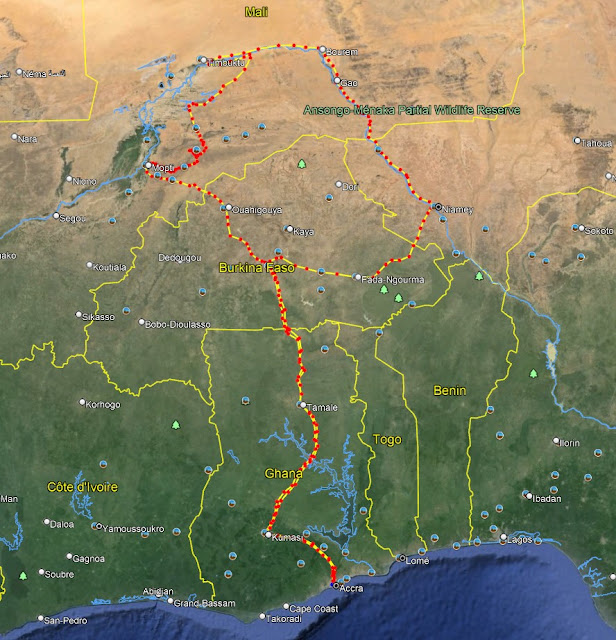 |
| Approximate route of road trip, following modern roads, so several hundred miles shorter, as roads were not there in 1957 |
